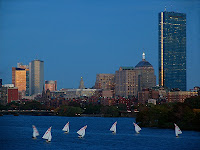 Post sunset is one of my favorite times to take photographs. I regularly go out and capture the Boston skyline at twilight on days that I am not occupied hunting for nature photographs. The best time is 20 to 30 minutes after the sun has set. The optimum light does not last long. Because twilight is hard to predict I set up my tripod and camera prior to the actual sunset and then fire away once the sun sets and disappears. This approach requires sufficient battery power and flash card memory to keep shooting while closing in on the optimum light. The twilight effect also works on cloudy days and 10-15 seconds exposure times are not unusual. I often set up on the BU bridge providing me with multiple challenges. First, there is the rush hour traffic that may cause shaking of the camera set up and therefore produce blurry photographs. Second, there are lots of pedestrians crossing the bridge and causing the same effect when passing by. And the final challenge is framing and composing the photographs in manual mode. In this photograph I decided to shoot landscape format and include the John Hancock building, a Boston landmark. I welcomed the BU sailing armada coming straight towards me because they added more interest to the foreground. The longer exposure time caused the sail boats to blur and added motion as well as an extra twist to the photograph. In the photograph below I used twilight to great effect in one of my nature photographs.
Post sunset is one of my favorite times to take photographs. I regularly go out and capture the Boston skyline at twilight on days that I am not occupied hunting for nature photographs. The best time is 20 to 30 minutes after the sun has set. The optimum light does not last long. Because twilight is hard to predict I set up my tripod and camera prior to the actual sunset and then fire away once the sun sets and disappears. This approach requires sufficient battery power and flash card memory to keep shooting while closing in on the optimum light. The twilight effect also works on cloudy days and 10-15 seconds exposure times are not unusual. I often set up on the BU bridge providing me with multiple challenges. First, there is the rush hour traffic that may cause shaking of the camera set up and therefore produce blurry photographs. Second, there are lots of pedestrians crossing the bridge and causing the same effect when passing by. And the final challenge is framing and composing the photographs in manual mode. In this photograph I decided to shoot landscape format and include the John Hancock building, a Boston landmark. I welcomed the BU sailing armada coming straight towards me because they added more interest to the foreground. The longer exposure time caused the sail boats to blur and added motion as well as an extra twist to the photograph. In the photograph below I used twilight to great effect in one of my nature photographs.Nov 25, 2009
On the BU Bridge
 Post sunset is one of my favorite times to take photographs. I regularly go out and capture the Boston skyline at twilight on days that I am not occupied hunting for nature photographs. The best time is 20 to 30 minutes after the sun has set. The optimum light does not last long. Because twilight is hard to predict I set up my tripod and camera prior to the actual sunset and then fire away once the sun sets and disappears. This approach requires sufficient battery power and flash card memory to keep shooting while closing in on the optimum light. The twilight effect also works on cloudy days and 10-15 seconds exposure times are not unusual. I often set up on the BU bridge providing me with multiple challenges. First, there is the rush hour traffic that may cause shaking of the camera set up and therefore produce blurry photographs. Second, there are lots of pedestrians crossing the bridge and causing the same effect when passing by. And the final challenge is framing and composing the photographs in manual mode. In this photograph I decided to shoot landscape format and include the John Hancock building, a Boston landmark. I welcomed the BU sailing armada coming straight towards me because they added more interest to the foreground. The longer exposure time caused the sail boats to blur and added motion as well as an extra twist to the photograph. In the photograph below I used twilight to great effect in one of my nature photographs.
Post sunset is one of my favorite times to take photographs. I regularly go out and capture the Boston skyline at twilight on days that I am not occupied hunting for nature photographs. The best time is 20 to 30 minutes after the sun has set. The optimum light does not last long. Because twilight is hard to predict I set up my tripod and camera prior to the actual sunset and then fire away once the sun sets and disappears. This approach requires sufficient battery power and flash card memory to keep shooting while closing in on the optimum light. The twilight effect also works on cloudy days and 10-15 seconds exposure times are not unusual. I often set up on the BU bridge providing me with multiple challenges. First, there is the rush hour traffic that may cause shaking of the camera set up and therefore produce blurry photographs. Second, there are lots of pedestrians crossing the bridge and causing the same effect when passing by. And the final challenge is framing and composing the photographs in manual mode. In this photograph I decided to shoot landscape format and include the John Hancock building, a Boston landmark. I welcomed the BU sailing armada coming straight towards me because they added more interest to the foreground. The longer exposure time caused the sail boats to blur and added motion as well as an extra twist to the photograph. In the photograph below I used twilight to great effect in one of my nature photographs.Nov 22, 2009
In Central Park
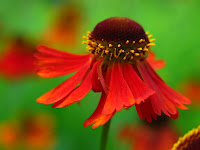 Last summer we spent quite some time in New York's Central Park. On the first morning we got up in the wee hours and waited in line to secure tickets to Shakespeare’s “Twelfth Night” with Anne Hathaway that night. At around noon we got four tickets and the show that evening in the public theater in New York Central Park was great. The very next morning we met up with our extended family and enjoyed a nice breakfast at a small outdoor cafe near the Central Park Carousel. As a passionate flower and nature photographer I realized the potential of the red and yellow Sneezeweed when we entered the cafe. After enjoying croissants, bagels and coffee with our family I stopped on the way out to capture some photographs. I used the fence to stabilize my camera since I didn't bring my tripod along. The Sneezeweed was in its full glory and it was not too difficult to locate one in front of a full green backdrop. All I had to do was compose my image with little depth of field to blur out background, focus on the petals and click away. The wind that day was quite strong and made it a greater challenge than expected but in the end I captured the photographs I was hoping for. I am very happy with the outcome of these two photographs on the fly.
Last summer we spent quite some time in New York's Central Park. On the first morning we got up in the wee hours and waited in line to secure tickets to Shakespeare’s “Twelfth Night” with Anne Hathaway that night. At around noon we got four tickets and the show that evening in the public theater in New York Central Park was great. The very next morning we met up with our extended family and enjoyed a nice breakfast at a small outdoor cafe near the Central Park Carousel. As a passionate flower and nature photographer I realized the potential of the red and yellow Sneezeweed when we entered the cafe. After enjoying croissants, bagels and coffee with our family I stopped on the way out to capture some photographs. I used the fence to stabilize my camera since I didn't bring my tripod along. The Sneezeweed was in its full glory and it was not too difficult to locate one in front of a full green backdrop. All I had to do was compose my image with little depth of field to blur out background, focus on the petals and click away. The wind that day was quite strong and made it a greater challenge than expected but in the end I captured the photographs I was hoping for. I am very happy with the outcome of these two photographs on the fly.
Nov 13, 2009
Monthly Photo Tip - November 2009
 While looking for the last colors of fall in the Boston area I ended up in the beautiful Arnold Arboretum. After working some ivy and shrubs over a bolder I came across these orange and red leaf trees. The leaves were showing peak color and screaming for a photographers eye. The drizzling rain accumulated on the tips of the leaves and gravity pulled the leaves downwards forming nature abstracts and a feast for any photographer. It took a few attempts to isolate a single leaf with a raindrop since a couple of times I moved in too close and instead of snapping the photo I ended up with the raindrop on my lens. In the end I found my leaf, zoomed all in and opened the aperture all up to blur out the background. The next photograph shows the same kind of leaves but from a different perspective. Here I focused on one of multiple rain soaked leaves and played with the depth of field. The settings were the same: long focus length and wide aperture setting to produce a shallow depth of field.
While looking for the last colors of fall in the Boston area I ended up in the beautiful Arnold Arboretum. After working some ivy and shrubs over a bolder I came across these orange and red leaf trees. The leaves were showing peak color and screaming for a photographers eye. The drizzling rain accumulated on the tips of the leaves and gravity pulled the leaves downwards forming nature abstracts and a feast for any photographer. It took a few attempts to isolate a single leaf with a raindrop since a couple of times I moved in too close and instead of snapping the photo I ended up with the raindrop on my lens. In the end I found my leaf, zoomed all in and opened the aperture all up to blur out the background. The next photograph shows the same kind of leaves but from a different perspective. Here I focused on one of multiple rain soaked leaves and played with the depth of field. The settings were the same: long focus length and wide aperture setting to produce a shallow depth of field.
Nov 12, 2009
Nov 9, 2009
Win a Free Greeting Card!
Email me where in the world I was 20 years ago to help make world history. The first one to email me the correct answer at
Juergenrothphotography@gmail.com
will be awarded a free greeting card from my Fine Art America portfolio. Jokes about the outfit will result in automatic disqualification :-)
Please include in the subject line of your email "Greeting Card" and send me your choice of image for your free greeting card from my FAA portfolio.
Good luck!

Juergenrothphotography@gmail.com
will be awarded a free greeting card from my Fine Art America portfolio. Jokes about the outfit will result in automatic disqualification :-)
Please include in the subject line of your email "Greeting Card" and send me your choice of image for your free greeting card from my FAA portfolio.
Good luck!

Nov 7, 2009
Nov 1, 2009
Near Streams, Rivers and Cascading Water
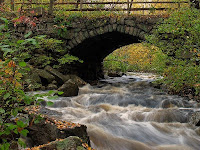 Moving water has become one of my favorite objects. These scenes are difficult to photograph but make for beautiful subjects. Sudbury River was one of my first of this kind. I first discovered the scene on a trip to one of my daugther's soccer games. The Fall foliage peak was almost over. When we came around the corner in our car I caught a glimpse of the bridge with the Sudbury river and committed the image to memory. Needless to say we won the game. Although the next day was overcast I decided to go back and work the object. Climbing down to the river was quite a hassle and adventure because of the slippery rocks and boulders but worth while. Turns out that overcast or twilight conditions are the most important ingredients when photographing moving water.
Moving water has become one of my favorite objects. These scenes are difficult to photograph but make for beautiful subjects. Sudbury River was one of my first of this kind. I first discovered the scene on a trip to one of my daugther's soccer games. The Fall foliage peak was almost over. When we came around the corner in our car I caught a glimpse of the bridge with the Sudbury river and committed the image to memory. Needless to say we won the game. Although the next day was overcast I decided to go back and work the object. Climbing down to the river was quite a hassle and adventure because of the slippery rocks and boulders but worth while. Turns out that overcast or twilight conditions are the most important ingredients when photographing moving water. 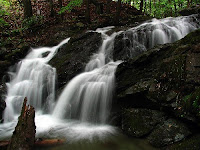 Shutter speed determines the silky effects. Short exposures freeze the water and often translates into less favorable images.
Shutter speed determines the silky effects. Short exposures freeze the water and often translates into less favorable images. 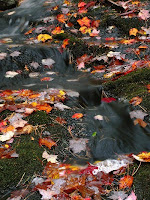 On the other hand, streaming waters provide wonderful silky shapes and patterns when longer exposure times are chosen.
On the other hand, streaming waters provide wonderful silky shapes and patterns when longer exposure times are chosen.A tripod for optimal image quality and minimum blurriness of the surrounding landscape during the longer exposure times is a must. The use of a polarizer filter eliminates reflections from wet surfaces and increases color saturation. The polarizer also reduces image brightness and provides longer exposure times, if needed.
Shutter speeds at around 1/2 through 1/15 of a second produce velvety and silky effects for streams, rivers and cascading water. Waves and surfs require shutter speeds around 1 second or more.
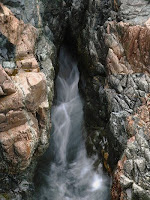

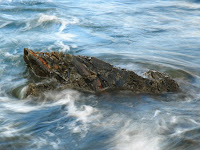
Subscribe to:
Posts (Atom)














